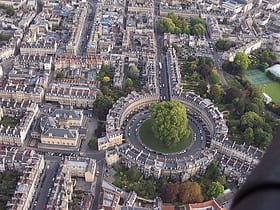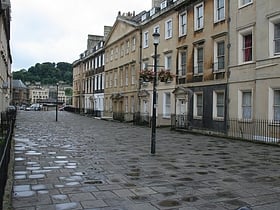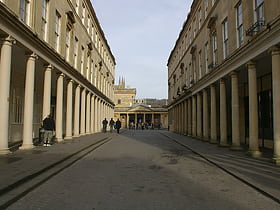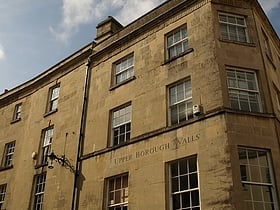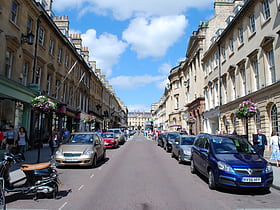Bath: Street
Places and attractions in the Street category
Categories
- Museum
- Church
- Street
- Georgian architecture
- Shopping
- Concerts and shows
- Park
- Theater
- Gothic Revival architecture
- Historical place
- Specialty museum
- Art museum
- Bridge
- Canal
- History museum
- Nightlife
- Outdoor activities
- Sport venue
- Sport
- Neighbourhood
The Circus
The Circus is a historic ring of large townhouses in the city of Bath, Somerset, England, forming a circle with three entrances.
Duke Street
Duke Street in Bath, Somerset, England was built in 1748 by John Wood, the Elder. Several of the buildings have been designated as Grade I listed buildings. The street, which overlooks the River Avon, is pedestrianised with no vehicles permitted to enter.
Bath Street
Bath Street in Bath, Somerset, England was built by Thomas Baldwin in 1791. Several of the buildings have been designated as Grade I listed buildings. It was originally named Cross Bath Street as it contains the Cross Bath. It is also the entrance to the much more recent Thermae Bath Spa.
Upper Borough Walls
Upper Borough Walls is a historic street in Bath, Somerset, England. Many of the structures are listed buildings. It takes its name from the section of the medieval wall of the city which still remains.
Milsom Street
Milsom Street in Bath, Somerset, England was built in 1762 by Thomas Lightholder. The buildings were originally grand town houses, but most are now used as shops, offices and banks. Most have three storeys with mansard roofs and Corinthian columns.
Norfolk Crescent
Norfolk Crescent in Bath, Somerset, England was built between c.1793 and c.1822 and has been designated as a Grade II* listed building. The original design was by John Palmer, but minor alterations were later made by John Pinch.
Sion Hill Place
Sion Hill Place in the Lansdown area of Bath, Somerset, England was designed by John Pinch the elder and built between 1818 and 1820. Suspension bridge builder and brewer James Dredge, Sr. lived here in the mid 19th century.
Great Pulteney Street
Great Pulteney Street is a grand thoroughfare that connects Bathwick on the east of the River Avon with the City of Bath, England via the Robert Adam designed Pulteney Bridge.
Trim Street
Trim Street in Bath, Somerset, England is an historic street, built in 1707, of shops and houses, many of which are listed buildings. It was named after George Trim who owned the land.
Kingsmead Square
Kingsmead Square in Bath, Somerset, England was laid out by John Strahan in the 1730s. Many of the houses are listed buildings.
Argyle Street
Argyle Street is a historic street in the centre of Bath, England located between Pulteney Bridge and Laura Place.
Gay Street
Gay Street in Bath, Somerset, England, links Queen Square to The Circus. It was designed by John Wood, the Elder in 1735 and completed by his son John Wood, the Younger. The land was leased to the elder Wood by Robert Gay, MP for Bath, and the street is named after him. Much of the road has been designated as Grade I listed buildings.
Stall Street
Stall Street in Bath, Somerset, England was built by John Palmer between the 1790s and the first decade of the 19th century. The buildings which form an architectural group have listed building status and are now occupied by shops and offices.
Bathwick Hill
Bathwick Hill in Bath, Somerset, England is a street lined with historic houses, many of which are designated as listed buildings. It climbs south east from the A36 towards the University of Bath on Claverton Down, providing views over the city.
North Parade
North Parade in Bath, Somerset, England is a historic terrace built around 1741 by John Wood, the Elder. Several of the houses have been designated as Grade I listed buildings.
Cheap Street
Cheap Street in Bath, Somerset, England is adjacent to Bath Abbey and contains several listed buildings. The road was known as Souter Street until 1398. Number 13 which adjoins the abbey and is Grade II* listed. Number 14 was built around 1720.
Laura Place
Laura Place Bathwick, Bath, Somerset, England, consists of four blocks of houses around an irregular quadrangle at the end of Pulteney Bridge. It was built by Thomas Baldwin and John Eveleigh between 1788 and 1794.
The Paragon
The Paragon in the Walcot area of Bath, Somerset, England is a street of Georgian houses which have been designated as listed buildings. It was designed by Thomas Warr Attwood. It now forms part of the A4. Numbers 1 to 21 are 3 storey houses with mansard roofs.
Sydney Place
Sydney Place in the Bathwick area of Bath, Somerset, England was built around 1800. Many of the properties are listed buildings. Numbers 1 to 12 were planned by Thomas Baldwin around 1795. The 3 storey buildings have mansard roofs. Jane Austen lived in Number 4 from 1801 to 1805.
Wood Street
Wood Street in Bath, Somerset, England was built in 1778 an has been designated as a Grade I listed building. The street was designed by John Wood, the Elder and built by Thomas Baldwin in the same style as the adjacent Queen Square.
Portland Place
Portland Place in Bath, Somerset, England was built around 1786 and many of the houses have been designated as listed buildings.
Nile Street
Nile Street in Bath, Somerset, England is a short street of Georgian houses linking Norfolk Crescent and Nelson Place West with the Upper Bristol Road. On the east side there are five houses, including the corner blocks to Great Stanhope Street and Monmouth Place.
Camden Crescent
Camden Crescent in Bath, Somerset, England, was built by John Eveleigh in 1788; it was originally known as Upper Camden Place. Numbers 6 to 21 have been designated as a Grade I listed buildings. The other houses are Grade II listed. The houses are of three storeys, with attics and basements.
Cavendish Crescent
Cavendish Crescent in Bath, Somerset, is a Georgian crescent built in the early 19th century to a design by the architect John Pinch the elder. At 11 houses, it is the shortest of the seven Georgian crescents in Bath.
Grosvenor Place
Grosvenor Place in Bath, Somerset, England was built around 1790 by John Eveleigh. It lies alongside the A4 London Road and many of the houses are listed buildings. Grosvenor House is a terrace of 42 houses, with double curves to the large central house.
Cavendish Place
Cavendish Place is a Georgian terrace in Bath, Somerset, England. It was built in between 1808 and 1816 by John Pinch the elder. Numbers 1 to 13 have been designated as Grade I listed buildings.
South Parade
South Parade in Bath, Somerset, England is a historic terrace built around 1743 by John Wood, the Elder. All of the houses have been designated as Grade I listed buildings.
Nelson Place West
Nelson Place West is a Grade II listed Georgian terrace of houses in Bath, Somerset, England. It was built as "Nelson Place" in the early 19th century, and the suffix "West" was added to avoid confusion with Nelson Place East on the other side of the city.
Johnstone Street
Johnstone Street in the Bathwick area of Bath, Somerset, England was designed in 1788 by Thomas Baldwin, with some of the buildings being completed around 1805-1810 by John Pinch the elder.
Pierrepont Place
Pierrepont Place is a mews street in Bath, England. Records indicate that Pierrepont Place and properties on it were built by John Wood the Elder between 1732 and 1748, on land once belonging to monks of Bath Abbey, who had used it as an orchard.
Henrietta Street
Henrietta Street in the Bathwick area of Bath, Somerset, England was built around 1785 by Thomas Baldwin. Numbers 1 to 35 were built together in a terrace with a consistent style of 3 storey houses. They complement the surrounding Georgian buildings and layout of Laura Place, Great Pulteney Street and Johnstone Street.
St James's Square
St James's Square in Bath, Somerset, England consists of 45 Grade I listed buildings. It was built in 1793 by John Palmer. It is the only complete Georgian square in Bath. Each of the 3 storey houses has a mansard roof. The central buildings have pediments on 4 Corinthian pilasters. In 1840 number 35 was the home of Charles Dickens.
Widcombe Crescent
Widcombe Crescent in Bath, Somerset, England is a terrace of 14 Georgian houses built in 1808 by Thomas Baldwin, and designated a Grade I listed building. The three-storey houses, which have mansard roofs, are stepped up from either side to central 2 houses which project slightly.
Map

